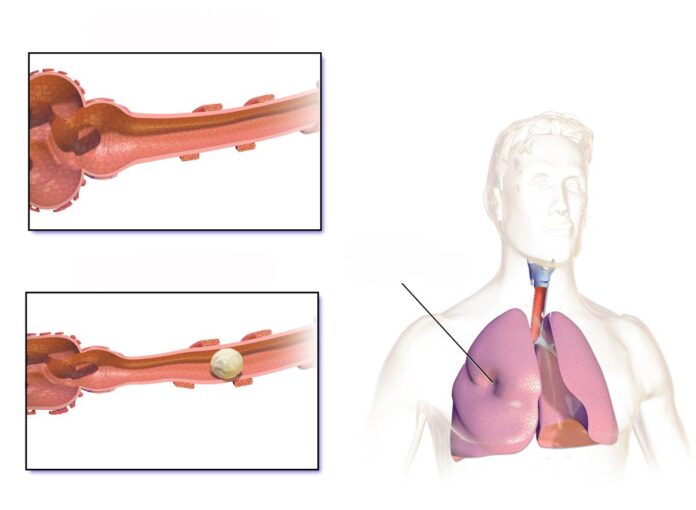
Understanding the Link Between Atelectasis and Lung Cancer: What You Need to Know
Lung cancer is the second most common cancer in both men and women, and it is the leading cause of cancer-related deaths worldwide. Atelectasis, on the other hand, is a condition that occurs when a part of the lung does not receive enough air, causing the affected area to collapse. While these two conditions may seem unrelated, there is a clear link between atelectasis and lung cancer that is important to understand.
In this article, we will explore the connection between atelectasis and lung cancer, how these two conditions are related, and what you need to know about their relationship.
What is Atelectasis?
Atelectasis is a condition that occurs when the small air sacs in the lung, known as alveoli, collapse, leading to a partially or completely collapsed lung. This can be caused by a variety of factors, including:
– Obstruction of the airways
– Surgeries such as heart surgery or lung resection
– Weak lung muscles
– Accumulation of fluid in the lungs
– Inflammation or scarring of lung tissue
– Tumors or growths in the lung
Symptoms of atelectasis can vary depending on the severity of the condition, but common symptoms may include shortness of breath, rapid breathing, chest pain, and coughing. In some cases, atelectasis may be asymptomatic and only discovered through imaging tests such as X-rays or CT scans.
What is Lung Cancer?
Lung cancer is a type of cancer that begins in the lungs and can spread to other parts of the body. The two main types of lung cancer are non-small cell lung cancer and small cell lung cancer, with non-small cell lung cancer being the most common type.
The most common cause of lung cancer is long-term exposure to tobacco smoke, but other factors such as exposure to radon gas, asbestos, and air pollution can also increase the risk of developing the disease. Symptoms of lung cancer can include a persistent cough, chest pain, hoarseness, weight loss, and shortness of breath.
Understanding the Link Between Atelectasis and Lung Cancer
There is a clear link between atelectasis and lung cancer, and understanding this link is crucial for early detection and treatment. One of the most common causes of atelectasis is the presence of a tumor or growth in the lung, which can obstruct the airways and lead to the collapse of lung tissue.
Additionally, surgeries to remove lung tumors or resect part of the lung can also lead to atelectasis as a post-operative complication. This is particularly true for surgeries that involve removing a large portion of the lung, as the remaining lung tissue may not fully expand, leading to collapse.
Furthermore, lung cancer can cause inflammation and scarring of the lung tissue, which can also contribute to the development of atelectasis. In some cases, atelectasis may be the first sign of lung cancer, prompting further investigation and diagnosis.
Diagnosis and Treatment
Diagnosing atelectasis and lung cancer often involves a combination of imaging tests, such as X-rays, CT scans, and PET scans, as well as lung function tests and biopsies. Treatment for atelectasis may include measures to re-expand the collapsed lung, such as deep breathing exercises, chest physiotherapy, and the use of a device called a incentive spirometer to encourage deep breathing.
In some cases, a bronchoscopy may be performed to remove any obstructing material from the airways. For lung cancer, treatment options may include surgery, chemotherapy, radiation therapy, targeted therapy, and immunotherapy, depending on the type and stage of the cancer.
Prevention and Early Detection
Preventing atelectasis and lung cancer involves reducing risk factors such as smoking, exposure to secondhand smoke, and occupational exposure to carcinogens such as asbestos and radon. Early detection is also key to improving outcomes for both atelectasis and lung cancer.
For atelectasis, early intervention to address underlying causes such as lung tumors, infections, or obstructions can help prevent the condition from progressing. For lung cancer, early detection through screening tests such as low-dose CT scans in high-risk individuals can help identify the disease at an earlier, more treatable stage.
It is also important to be aware of the symptoms of atelectasis and lung cancer, especially if you have a history of smoking or have been exposed to carcinogens. Seeking medical attention for persistent symptoms such as coughing, chest pain, and shortness of breath can lead to an earlier diagnosis and better outcomes.
Conclusion
In conclusion, atelectasis and lung cancer are two closely related conditions that share a common link through the development of lung tumors, inflammation, and scarring. Understanding the connection between these two conditions is crucial for early detection, treatment, and prevention.
By recognizing the symptoms of atelectasis and lung cancer, reducing risk factors, and seeking medical attention for persistent symptoms, individuals can improve their chances of early diagnosis and better outcomes. With advancements in screening and treatment options, there is hope for better outcomes for individuals affected by atelectasis and lung cancer.












